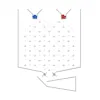Take a look inside 5 images
Turing Tumble Simulator
Pros: Simple way to teach complex concepts, and it's easy to test theories and revise.
Cons: Little documentation and lack of tutorial make it difficult for students to create meaning on their own.
Bottom Line: This bare-bones simulation is useful for teaching computer science concepts, but only as part of a teacher-supported environment.
Turing Tumble Simulator is so open-ended that it's both versatile and potentially labor-intensive for educators who want to insure students get the most out of it. Use it to explain computer science and engineering concepts like circuit design, binary operations, and logic gates. Utilize the educational resources from the original game to aid in assigning learning challenges.
You can also focus on the problem-solving involved if you create your own challenges. Talk through the executive functioning needed to decide in what order the steps should go. Have students explore metacognition as they observe their own thinking while solving the puzzles you pose. Or you could take learning offline and have students build a physical model of a binary computer. Since it was made with GitHub, you can also talk about open-source software. Whatever you choose, students will definitely need some scaffolding to understand the tool and make meaning from the results.
Turing Tumble Simulation is a digital simulation of a real-world puzzle-based game that's meant to teach students computer science and engineering concepts. In it, students place a series of switches, gates, and other pieces on a board. Two sets of colored marbles are sent down the board to test the design and obtain final results. Turing Tumble Simulation can do a variety of simple calculations using binary operations, just like a computer. While there is an explanation of the icons on the board, there's no included tutorial or activity pack, as you'd find with the real-world game, so some teacher support is essential.
By itself, Turing Tumble Simulation stumbles in educating students. Since it lacks a tutorial or any educational guidance, it's rather like handing students a calculator and hoping they'll learn math. Without a basic understanding of what they're doing, why they're doing it, and how it connects to things like binary operations, students will likely falter and lose interest.
However, when paired with the toolkit provided by the original Turing Tumble game team (or similar activities designed by the teacher), it becomes a powerful visual introduction to how computers work and why. And while it lacks the tactile experience of the boxed game, it also minimizes false starts, physical disruptions, and lost marbles.













